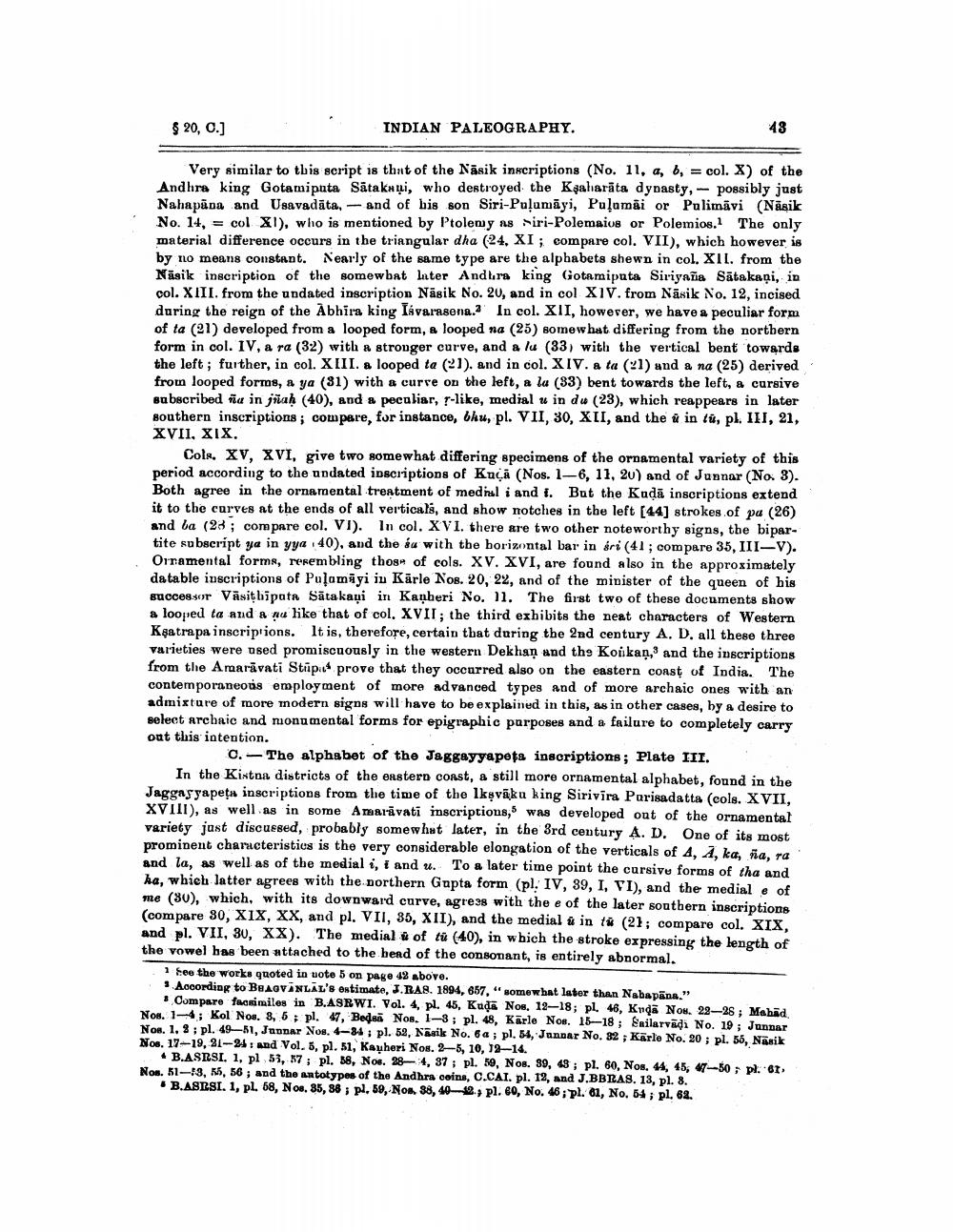________________
$ 20, C.]
INDIAN PALEOGRAPHY.
43
Very similar to this script is that of the Nāsik inscriptions (No. 11, a, b, = col. X) of the Andhra king Gotamiputa Satakuti, who destroyed the Kaaharāta dynasty, - possibly just Nahapana and Usavadāta, -and of his son Siri-Puļumāyi, Pulomai or Pulimävi (Näsik No. 14, = col XI), who is mentioned by Ptolemy as Siri-Polemaios or Polemios. The only material difference occurs in the triangular dha (24, XI ; compare col. VII), which however is by no means constant. Nearly of the same type are the alphabets shewn in col. XII. from the Näsik inscription of the somewbat Inter Anders king Gotamiputa Siriyağa Sätakaội, in col. XIII. from the undated inscription Näsik No. 24, and in col XIV. from Näsik No. 12, incised during the reign of the Abhira king Isvarasena. In col. XII, however, we have a peculiar form of ta (21) developed from a looped form, a looped na (25) somewhat differing from the northern form in col. IV, a ra (32) with a stronger curve, and a lu (33) with the vertical bent towards the left; further, in col. XIII. a looped ta (21). and in col. XIV. a ta (21) and a na (25) derived from looped forms, a ya (81) with a curre on the left, a la (33) bent towards the left, a cursive subscribed via in jñaḥ (40), and a peculiar, r-like, medial u in du (23), which reappears in later southern inscriptions; compare, for instance, bhu, pl. VII, 30, XII, and the û in tủ, pl. III, 21, XVII, XIX.
Cols. XV, XVI, give two somewhat differing specimens of the ornamental variety of this period according to the updated inscriptions of Kuça (Nos. 1-6, 11, 20) and of Junnar (No. 3). Both agree in the ornamental treatment of medial i and I. But the Kudā inscriptions extend it to the curves at the ends of all verticals, and show notches in the left [44] strokes of pa (26) and ba (27; compare col. VI). In col. XVI. there are two other noteworthy signs, the bipartite subscript ya in yya 40), and the sa with the horizontal bar in sri (41; compare 35, III-V). Ornamental forms, rerembling those of cols. XV. XVI, are found also in the approximately da table inscriptions of Pulamiyi iu Kārle No. 20, 22, and of the minister of the queen of his SUCC&sor Vasithipata Sätakaại in Kanheri No. 11. The first two of these documents show a looped ta and a nu like that of col. XVII; the third exhibits the neat characters of Western Kgatrapa inscriptions. It is, therefore, certain that during the 2nd century A. D. all these three varieties were used promiscuously in the western Dekhan and the Konkan, and the inscriptions from the Amaravati Stip* prove that they occurred also on the eastern coast of India. The contemporaneous employment of more advanced types and of more archaic ones with an admixture of more modern signs will have to be explained in this, as in other cases, hy a desire to select archaic and monumental forms for epigraphic purposes and a failure to completely carry out this intention.
C. -The alphabet of the Jaggayyapeta inscriptions ; Plate III. In the Kitna districts of the erstern coast, a still more ornamental alphabet, found in the Jaggayyapeta inscriptions from the time of the Ikšvāku king Sirivira Parisadatta (cols. XVII, XVIII), as well as in some Amaravati inscriptions, was developed out of the ornamental variety just discussed, probably somewhat later, in the 3rd century A. D. One of its most prominent characteristics is the very considerable elongation of the verticals of A, Ā, ka, ha, ra and la, as well as of the medial i, i and u. To a later time point the cursivu forms of tha and ha, which latter agrees with the northern Gupta form (pl. IV, 39, I, VI), and the medial e of me (80), which, with its downward curve, agress with the e of the later southern inscriptions (compare 30, XIX, XX, and pl. VII, 35, XII), and the medial a in tử (21; compare col. XIX, and pl. VII, 30, XX). The medial of tů (40), in which the stroke expressing the length of the vowel has been attached to the bend of the consonant, is entirely abnormal.
i fee the works quoted in uote 5 on page 42 above.
According to BeaGVANLAL'S Ostimate, J.RAS. 1894, 657,"somewhat later than Nabapana." . Compare fuosimiles in B.ASRWI. Vol. 4. pl. 45, Kuda Nos, 12-18; pl. 46, Knça Now. 29-28; Mahad. Nou. 1-4; Kol Nou. 8, 6: pl. 47, Bedai Nos. 1-3; pl. 48, Kärle Nos. 16-18; Snilarvadı No. 19; Junnar Non, 1, 8: pl. 49-51, Junnar Nos. 4-84. pl. 52, Nasik No. 6a ; pl. 54, Junnar No. 32, Karle No. 20; pl. 56, Ninik Nos. 17-19, 21-24 and Vol. 5, pl. 51, Kayheri Nou. 2-5, 10, 12-14.
B.ASRSI, 1, pl 53, 17; pl. 88, Noe. 284, 37; pl. 50, Nos. 39, 13; pl. 60, Nos. 44, 45, 47-50, pl. Non. 61-13, M5, 56 ; and the antotypes of the Andhrs coins, C.CAL. pl. 12, and J.BBRAS. 13, pl. 8.
. B.ASRSI, 1, pl. 58, No. 85, 88 ; pl. 19, Nos 38, 402 , pl. 60, No. 46; pl. 01, No. 6, pl. 62.




